2007 VOLKSWAGEN GOLF PLUS wheel
[x] Cancel search: wheelPage 196 of 541
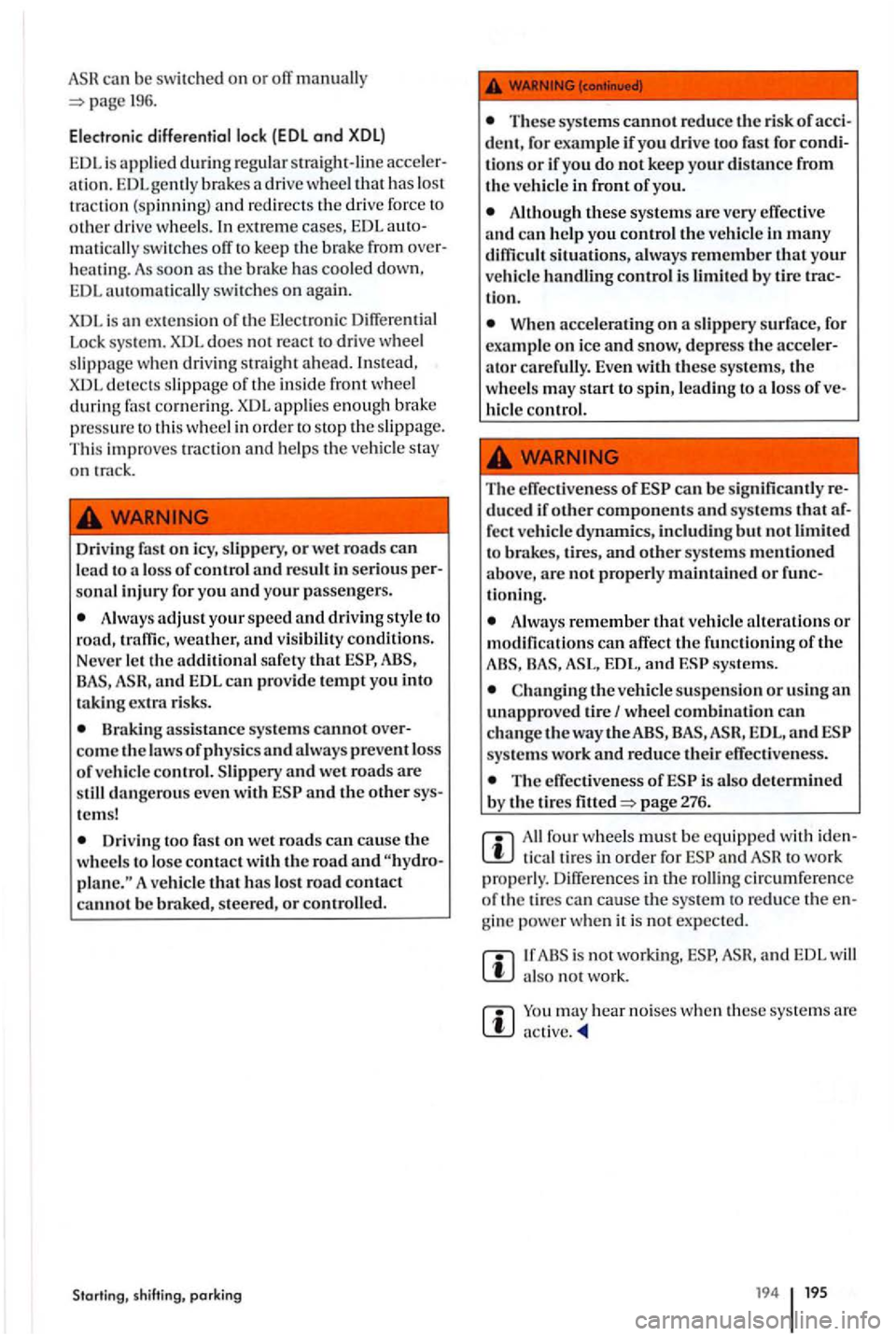
can be swi tched on or off
196.
Electr onic differential lock (EDL ond XDL)
EDL is applied during regular straight-li ne at ion. brake s a drive wheel that has lost
trac tio n (sp inn ing) and r edi rects the drive force to
o th er drive whee ls. In ext re m e cases, EDL from h eating. As soon
loss of contro l a nd result in serious sonal inju ry for yo u and yo ur passe ngers.
A lw ays adjust your s peed and driv in g s ty le to
road, traffic,
r is ks.
B rakin g ass istance syste m s cannot come th e laws of p h ys ics an d always prevent loss
o f vehi cle control. Slipp ery and wet roads are
s till da ngero us eve n with
te ms!
D rivin g to o fast on wet roads cause th e
w heels to lose contact w ith the road and A vehicl e that h as los t road contact
canno t b e brake d, steered , or controlled .
Start ing, sh ifti ng, parkin g
These syste ms cannot red uce th e risk of
Althoug h th ese syste m s a re very eff ec tive
a nd can h elp yo u control tile ve hicle in man y
diffi cult situatio ns, always remember th at your vehicle
W hen acce le ra tin g o n a slippery surface, fo r
exam ple o n icc and sn ow, depress the
''
can b e sig nificantl y duced if other components and sys tems that
ti onin g.
A lways re m ember th at ve hicl e
syste m s.
Cha nging the vehi cle su sp ens io n or using an unapproved tire w heel combinati on ca n
c h a ngethewayth eABS, EDL, and syste ms work and reduce their effecti ve ness.
T he effective ness of page 276 .
All fo ur w hee ls must b e equip ped with tic a l tir es in order for to wo rk
properly. Differences in th e
g ine powe r w he n it is not expected.
I f is not working, and EDL will also not work.
active.
Page 200 of 541
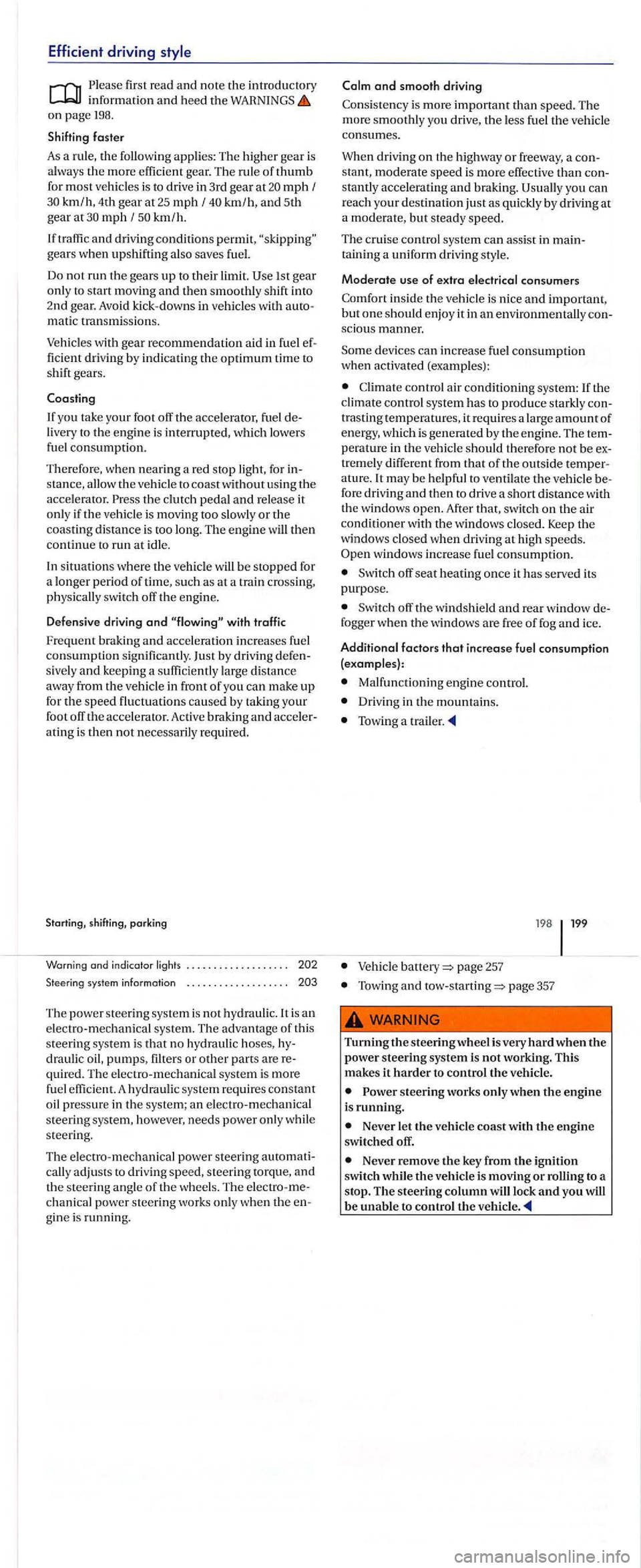
Efficient driving
Please information and heed the on page 198.
Shifting faster
As a rule, the following applies: The higher gear is
a lways the more efficient gear. The rule of thumb for most vehicles is to drive in 3rd gear at mph f km/h, 4th gear at 25 mph f km/h, and 5th gear at mph f km /h.
If
and driving conditions permit, gears when upshifting also saves fuel.
Do
not run the gears up to their limit.
mati c transmissions .
Vehicles with gear recommendation aid in fuel fic ient dri ving by indicating the optimum time to shift gears.
livery to the engine is interrupted, which lowers
fuel consumption.
T herefore, when nearing a red stop light , for s tanc e, allow the vehicle to coast without using the accelera tor. Press the clutch pedal and release it only if the v ehicle is moving too slowly or the coasting distance is too long. The engine will then continue to run at idl e.
In situati ons
where the vehicle will be stopped for
a longer period of time, such as at a train cros sing,
physically switch off the engin e.
D efens ive driving
and with traffic
Fre
quent braking and accel eration increases fuel consumption sign ific antly. Just by driving sivel y and keeping a su fficiently large distance away fro m the vehicle in front of you can make up for the speed fluctuation s caused by taking your foot off the accelerator. Active braking and ating is then not necessarily required.
system information
The power stee ring syste m i s not hydrauli c.lt is an electro-mechanical syste m. The advantage of this
s te ering system is tha t no hydra uli c hoses, draulic oil, pumps, filters or other parts are quired . Th e e lectro-m echanica l system is more fue l effi cient. A hydraulic system requires constant oil pressure in the syste m; an electro -mechanical
s teerin g sys tem, however, needs power only whil e
s teering.
Th e el
ectro-mechanical power steering
chanical power steering works only when the gin e is running.
and smooth driving
Consistency is more important than speed. The more smoothly yo u drive, the less fuel the vehicle consumes.
When driving on the highwa y or freeway, a
stantly accelerating and braking. you can r each your destinatio n just as quickly by driving at a moderate, but steady speed.
The c rui se control syste m can a ssis t in
sciou s manner.
Some dev ices can increase fuel consumption when activated (examples):
C limate control air conditioning system:
trasting temperatures, it requires a large amount of energy, which is generated by the e ngin e. T he
tr emely different from that of the outside
windows increase fuel consumption.
Switch off seat heating once it has served its
purpose.
Sw itch off the windshield and rear window
Malfunctioning engine control.
Driving in the mountains.
Towing a trailer .
page 257
Towing and page 357
Turning the steering wheel is very hard when the power steering system is not working. This makes it harder to control the vehicle.
steering works only when the engine is running.
Never let the vehicle coast with the engine switched off.
Never remove the key from the ignition
switch while the vehicle is moving or rolling to a
stop. The steering column will lock and you will be unable to control the vehicle.
Page 202 of 541

Steering system information
first read and note the introductory informatio n and heed the on page
To help m ake it more diffi cult to s teal your ve hicl e,
you sh ould always make sur e the steering co lumn is locked before leaving the ve hicle .
Electronic steering column lock
Vehicles with o
ut The s teering column is
l ocked if the vehicle is stationary and the vehicle
k ey is removed from the ign ition lock. The elec
tr onic s teering column will not lock if the vehicl e is
s till mov in g for longe r than seconds after the ve
hicl e key was re moved.
Vehicles with
Th e s teering column is
l ocked if the dri ver door is ope ned with the ignitio n switch ed ofT. For this, the ve hicle should be
s tationary if applic abl e, the gear selector leve r
s h ould be in
If the driver door is opened befo re the ign ition is
sw itch ed
188.
H e
move th e ve hicl e
k ey.
Turn th e s teering
w heel s lig htl y until you
hear the steering
column l oc k en gage.
Starting, shifting , parking
Disengaging the
steering column lock
Turn the s teering
whee l s lightl y to take pressure ofT the
s teerin g column lock.
In
sert the ve hicl e key
into the ignition swit ch .
Ho ld th e s teerin g
wheel in thi s pos ition
and turn the ignition switch.
steering
The e lectro-mechanical power steering auto m ati
c ally adjusts to dri ving speed, steering torque , and the steering angle of the wheels . The e lectro-me
c hanical power steering work s only w hen the en
gine is running.
If power steering is reduced or lost comple tely, it
will b e much harder to steer and co ntrol the ve
hicl e.
Counter-steering
assistance
T he feature
m akes it easier for the dri ver to control the vehicle
in difficult situation s. For exampl e, if yo u h ave to
brak e h
ard on a surface that provides uneve n t rac
tion, the ve hicle could pull to the right or l eft. detect s th is situation and h elps th e dri ver counter
s teer with additi onal steerin g
The counter-steering ass istance In
Page 229 of 541
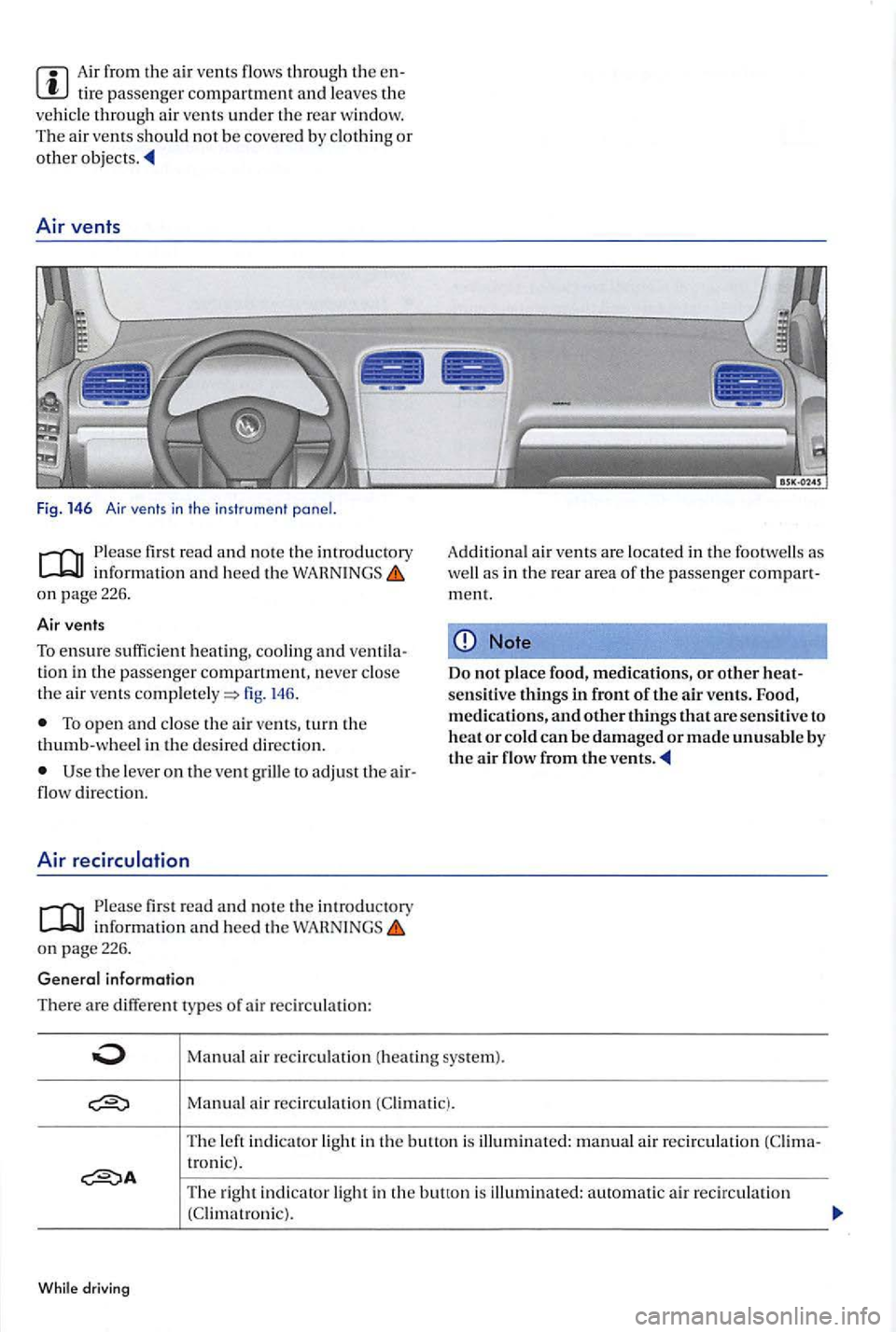
Air from the air vents flow s through the e ntire passenger compartment and leaves the vehicle through air vents under the rear w ind ow.
The a ir vents s hould not be covere d by clothin g or other
Air vents
Fig. 146 Air vents in the instrument
Please fir st read and no te th e introductory informati on and heed the on page 226.
Air
vents
To e n sure s uffici ent heating, cooling and ve ntil ation in the passenger compartment, n eve r close the air vents fig. 146 .
To ope n and close the air vents. turn the thumb-wheel in the desired direction.
Use the lever on the vent grill e to adj ust the air
flo w direction.
Air recirculation
Pleas e fir st re a d and note the in trod uctory information and heed the on page 226.
General information
There are different t y p e s of air recirculati on : A
dditi onal air
vents are located in the foorwells as well as in the rear area of the passe nger compart
m ent.
Note
Do not place food, medications, or other heatsensiti ve things in front of the air vents. Food, medications, and other things that are sensitive to
heat or cold can be damaged or made unusable by the air flow from the
Ma nual air re circulati on (h eatin g sys te m ).
Manual air r e circulatio n
troni c).
Th e
right indi cato r light in the is illumin ate d : automatic air recir cul atio n
Page 234 of 541
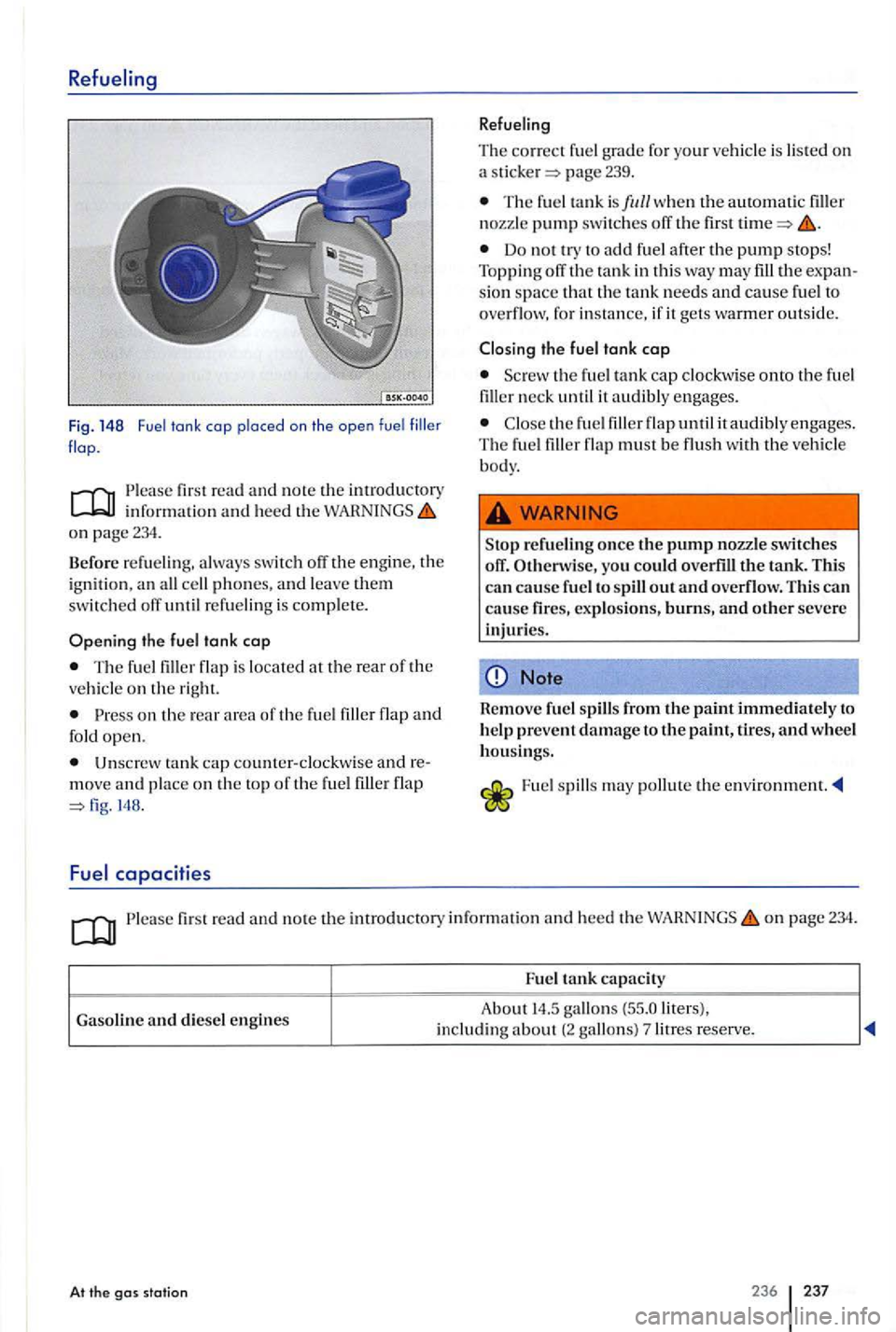
Fig. 148 Fuel tank cap placed on the ope n fue l
Please first read and note the introductory information and heed th e on page 234.
Before refueling, always switch off the eng in e, the
i gnition , a n all cell phones, and leave the m
switc h ed off until refue lin g is complete.
Opening th e fuel tank cop
The fuel filler flap is loca ted at t h e rear of the ve hicl e on the rig ht.
Pr ess on the rear area of th e fu el fille r flap and fo ld open.
flap
capacities
Refueling
Th e correct fu e l grade for your ve hicle is lis te d on a page 239.
The fue l tank is w he n the automatic filler
no zzle pump switche s off the first
Do not t ry to add fu el afte r the pump stops!
Topping off the tank in thi s way may ftll the expan
s ion space that the tank need s and cause fuel to
ov erfl ow, fo r insta nce, if it gets warmer outsid e.
C lo sing the fuel tank cop
onto the fuel filler n eck until it audibl y enga ges.
th e fu el fille r flap until it aud ib ly e nga ges.
T he fuel filler flap must be flu sh with the ve hicle
body.
refu elin g once the pump nozzle switch es
off. you could
Note
Remov e fu el sp ill s from the paint immediately to
h e lp prevent damage to the paint, tires, and wheel hou sing s.
P lease firs t rea d and no te the introduc tory inform ation and heed the on page 234.
F u e l t a
nk capaci ty
A
bout liters ),
i nclud ing about (2 gallons) re se rve . Gaso line and diesel e n g ines
A t th e gas station 236 237
Page 259 of 541
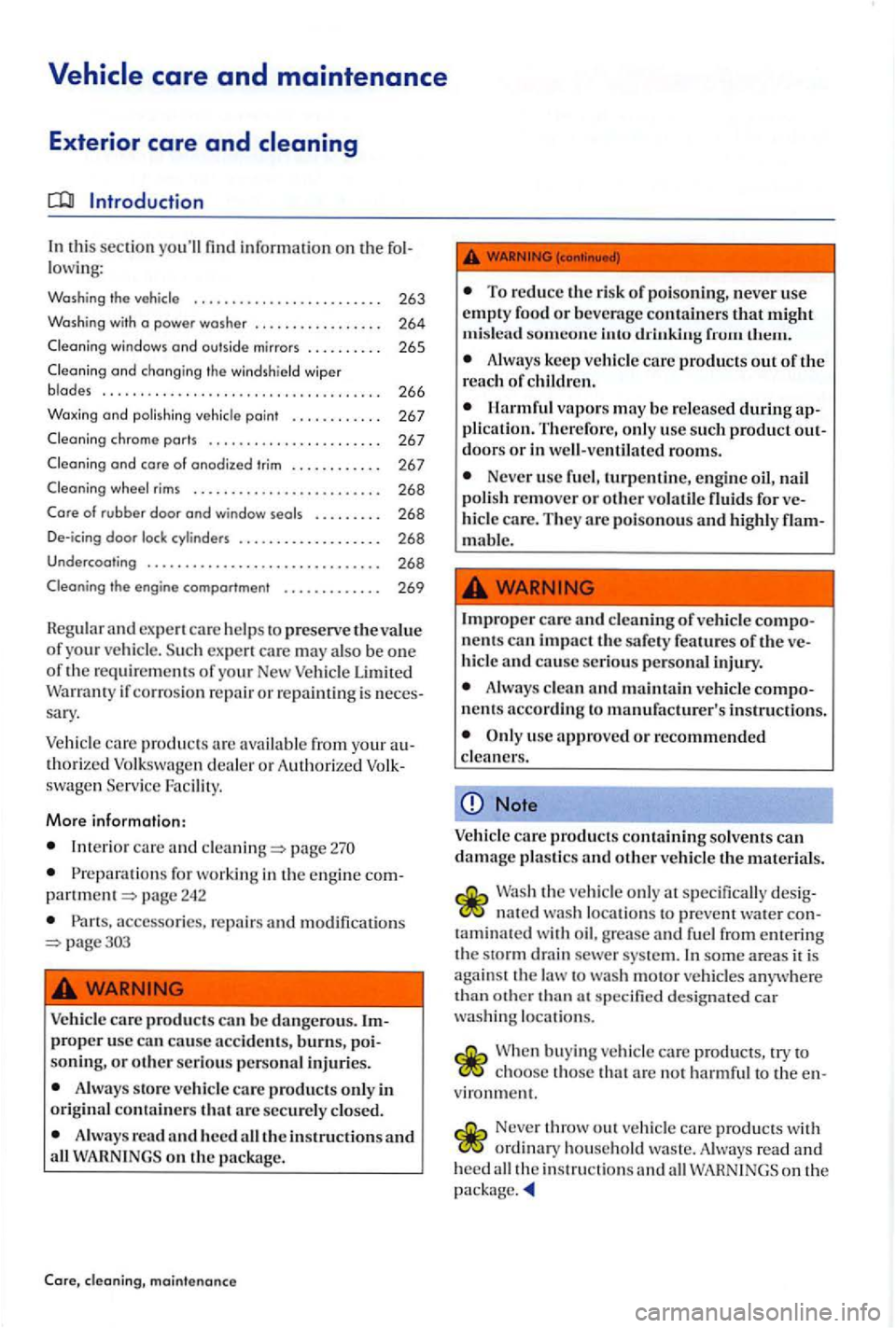
In this section information on th e fol
l owing:
Washing the vehicle . . . . . . . . . . . . . . . . . . . . . . . . . 263
Washing with a power washer ................ .
Cleaning windows
and outside mirrors ......... .
Cleaning
and changing the winds hield wiper
b l
ades .......................
. . . . . . . 267
Cleaning wheel rims . . . . . . . . . . . . . . . . . . . . . . . . . 268
Care of rubber door and window seals . . . . . . . . . 268
De-icing door lock cylinders . . . . . . . . . . . . . . . . . . . 268
Undercoating . . . . . . . . . . . . . . . . . . . . . . . . . . . . . . . 268
Cleaning the engine comportment ....... -. . . . . 269
Regu l
ar and expert ca re helps to preserve the value of your vehicle. expert care may also be o ne of th e requirements of you r New Vehicle Lim ited if co rros ion re pair or repa intin g is neces
s ary.
Veh icle care produc ts avai lable fro m your au
th orized Volkswagen d eale r or A uthorized
Int erio r care and page
Preparations for work ing in the e ngine compage 242
Parts. accessorie s. repair s and modifications
Vehicle care produc ts ca n be dangerous. Im
proper usc c a n cause accid ents, burns, poisonin g, or oth er seri ous persona l injuries.
Alway s sto re vehicle care products only in o rigina l co ntainers that are securely closed.
Alway s read and heed all th e in structions and all o n the pac kag e.
To reduce the risk of poiso ning, never usc empty food or beverage containers that might m is lead someone int o frum
A lways keep vehicl e ca re products out of the reach of childre n .
Never usc fuel, turpentine, eng in e o il, nail poli sh r emov er or ot her vo la til e fluid s for ve
hicl e ca re. They are po isonous and hi ghl y flam
mable.
Improper care and cleaning of ve hicl e component s can impact the safe ty feature s of the ve
hicl e and cause serio us personal injury.
A lways clea n and maintain vehicl e component s according to manufacturer's instructions.
use ap1>roved or recomm ended
clean ers.
Vehi cle care products containing s olvents can damage plastics and other ve hicl e th e material s.
Wash th e ve hicl e only des ig nated was h loca tio ns to preve nt wa ter con
t a minated with oil. grease and fuel from enterin g the storm drain sewe r system. In some are a s it is
a gains t th e to wash motor ve hicles anywhere than other than sp ecified design ated car
was hing locatio n s.
choo se those that are no t harmful to the environ ment.
Never th row out ve hicl e care produ cts with ordina ry house ho ld waste. Always read and hee d all th e in structi ons and on the
Page 260 of 541
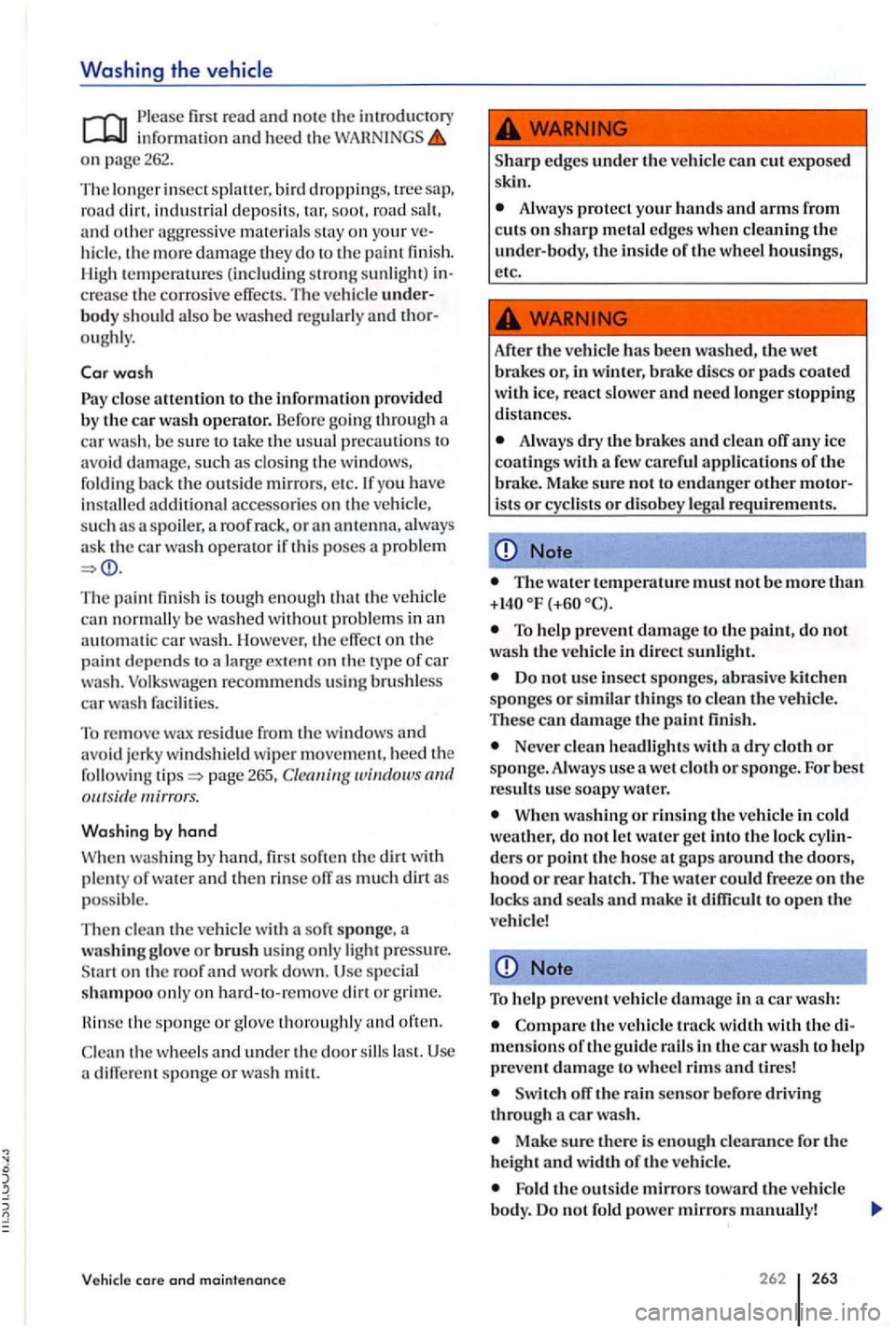
Washing the
fir st read and note th e in formatio n and heed th e on page 262.
The lo nge r insect splaue r, b ird droppings. tree sap,
road din, indu strial depo sits, road and o ther aggressive materials sta y on your ve
hicle , more damage they do sunlight ) crease the corros ive effects. The vehicle underbody sh o uld als o be was hed regularl y and thor
o ughly.
to the information by the car wash operator. Before going through a
ca r wash , b e s ure
you have installed addition al accessorie s on the vehicle, su ch as a spoiler, a roof rack, or an ant enna, alway s
a sk th e car was h opera tor if thi s po se s problem
The paint finish is
dep end s a la rge exte nt on th e rype of ca r
was h. Volk swagen recommend s using brush le ss
ca r w as h faciliti es.
' l b
rem ove wax res idu e from th e windows and
avoi d jerky wind shi eld wip er move m ent , heed the
f ollow ing page 265, outsi de
w ith
on the roof and work down. Usc sp ec ia l shampoo only on hard-to -remove or grim e.
Hinsc
different sponge or wash mill.
edges under the vehicle
Always protect your hands
Alway s dry the brakes and clean off any icc
coatings with a few caref ul appli cations oftlte brake. Make sure not to endanger other motoris ts or cyclists or disob ey lega l requirement s.
Note
The water temperature mus t not be more than
To help prevent damage to the paint, do not wash the vehicle in direct sunlight .
Do not use insect sponges, abrasive kitchen
s ponges or similar things to clean the ve hicle .
These can damage the paint finish.
Neve r clean headlight s with a dry cloth or sponge. Always use a
When washin g or rinsing the vehicle in cold
weather, do not let water get into the lock cylin ders or point the hose The water could freeze on the locks and seals and make it difficult to open the vehicle!
Note
To help prevent vehicle damage in a car wash:
the vehicle track width with the di
men sion s of the guide rail s in the car wash to help prevent damage to wheel rims tires!
off the rain sensor before driving
through a wash .
Mak e sure there is enough clearan ce for the height and width of the ve hicle.
Fold the outside mirrors toward the vehicle
body. Do not fold power mirrors manually!
262 263
Page 265 of 541
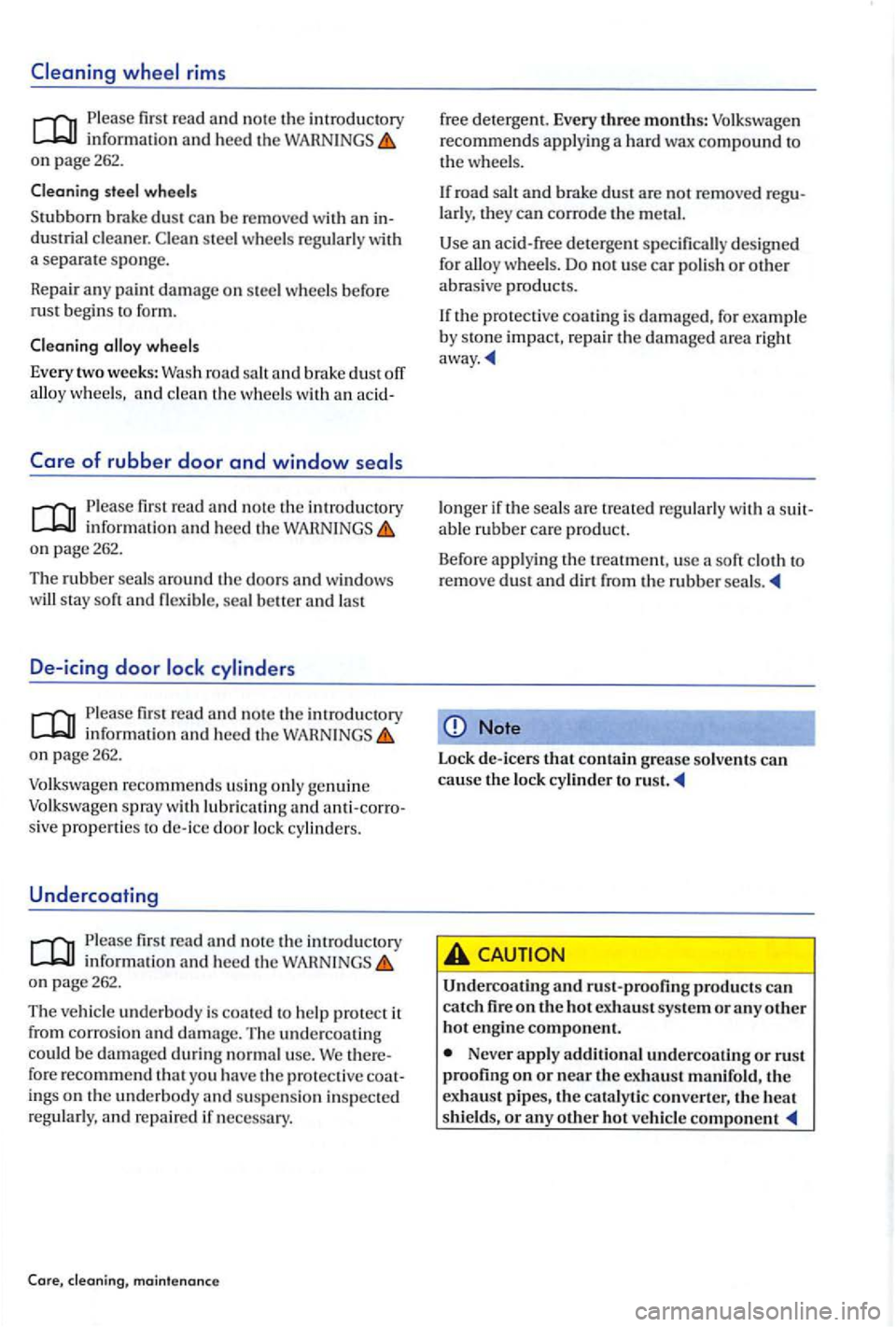
rims
Please fir st read and no te the introducto ry inform atio n and heed the WARN INGS on page 262.
Cleaning
steel wheel s
S
tubborn brake dus t can b e removed an in dustrial clean e r. s teel wheel s regularly with
a se pa rat e s po nge.
Repai r any paint damage o n steel wheels befor e rust begins to fo rm .
Cleaning alloy
wheels
Every two weeks: Wash road salt and brak e dust ofT alloy wheel s, and clean the w heels w ith an ac id-
of rubber door and window
Please information and heed the WARNINGS on p age262.
T he
rubbe r seals around the d oors and w indow s
will s ta y soft a nd flexib le, sea l bett er and la st
De-icing door
Please informatio n and heed th e WARNINGS on page 262.
Volkswage n recommends us in g only genuine Volkswagen spray with lubricating and anti -corro
s iv e pro perti es de-ice door lock cylind ers.
Undercoatin g
Ple ase read and n ot e the introductory heed th e o n page 262.
The ve hicl e underbody is co ated to help protect it
f rom corrosio n and damage. The undercoating could b e damaged durin g normal u se. We there
for e recommend that you have the protectiv e coatin gs on the underbody and su sp e nsion in spected
regularly, and repaired if necessary.
compound to the wheel s.
road and brake dust are not re m ove d regu
larly, they can corrode m etal.
the protective coating is damaged, fo r example
b y s tone impact, repai r the damaged area right
longer if the seals are treat ed regu larly with a suit
able rubbe r care product.
B efor e applyin g the treatment, usc a soft cloth to
r emove dust and dirt from the rubber
Lock de-ic ers that contain grease solvents can cause the lock cylinder to
Undercoating and rust-proofin g products can catch fire on the hot ex h au st sy stem or any othe r
h ot engine componen t.
Neve r apply additional undercoating or rust
proofi ng on or near the ex hau st manifold, the exhaust pipes, catalytic converter, the heat s hields, or any oll 1e r hot vehi cle component